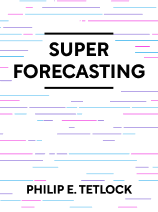

This article is an excerpt from the Shortform book guide to "Superforecasting" by Philip E. Tetlock. Shortform has the world's best summaries and analyses of books you should be reading.
Like this article? Sign up for a free trial here .
What is outside-in thinking? How does it relate to forecasting and prediction-making?
Outside-in thinking is the way of perspective-taking that draws information from the broader context first. Only after taking into account the bigger picture, the particular details of a situation are considered.
Read about outside-in thinking, as it relates to forecasting.
What Is the Outside-in Thinking?
Outside-in thinking is a mode of thinking that is premised on considering the bigger picture first (“outside view”) and only then considering the details (“inside view”).
- For example, imagine you are given a description of a particular family and asked the likelihood of that family having a pet. If you take the inside view, you’ll focus on the unique details of that family—the number of children and parents, their financial situation, ethnicity, personalities, and so on. You’ll really be answering the question, “Are these the sort of people who are likely to have a pet?”
- By contrast, starting with the outside view means ignoring all those details and focusing on the wider context of the question. Instead of thinking about whether the family seems like the type to have a pet, you’d be answering the question “What percentage of families have a pet in general?”
By nature, our storytelling minds gravitate toward the inside view. Statistics are dry and abstract—digging into the nitty-gritty details of family relationships is much more exciting. But that natural tendency can quickly lead us astray. If we’re told that the family has three children, lives on a farm, and loves dogs, we might say it’s 90% likely they have a pet. On the other hand, if we’re told they live in a cramped city apartment and work long hours, we might swing to the other extreme and guess 10%.
The problem is that we have no way of knowing how extreme those answers are. For that, we need a base rate to give us an idea of how common it is to own a pet in general. In reality, about 62% of American households have a pet. So a guess of 90% is much closer to the mean than a guess of 10%, which means that a 10% guess is much more likely to be wrong.
Often, there are multiple outside views to consider. For example, if we know the family lives in Rhode Island (where only 45% of households have a pet), we might need to lower our base rate significantly. Choosing the most fitting outside view of the situation is important.
But why is outside-in thinking superior to inside-out thinking? Why does it matter which view we start with? If we’re going to adjust our initial outside-view guess based on information from the inside view, wouldn’t the reverse give the same answer? If we were computers, maybe. But human minds are vulnerable to a psychological concept called anchoring. The number we start with has a powerful hold on us, and we tend to under-adjust in the face of new information.
For example, in the pet ownership question, if we start with an inside view guess of 10%, then move to an outside view of 45%, we’d bump our original number up, but only slightly—maybe to 15%. In this case, our anchor came out of thin air and significantly skewed the final results. But if we start with an anchor of 45% (outside view), then move to an inside view and see that the family doesn’t seem like the type to have pets, we might adjust that number down to 30%. Since most families fall relatively close to the mean, our outside-in guess is far more likely to be accurate.
Forecasting questions are rarely as simple as whether a certain family has a pet, and the inside view is often a huge, messy collection of details. In that case, outside-in thinking is more optimal. We need to decide what unique aspects of the situation are important and then focus on understanding those in detail.
Example: Predicting Terrorism
In January of 2015, a superforecaster named David Rogg was asked to predict whether there would be a terrorist attack carried out by Islamist militants in France, the UK, Germany, the Netherlands, Denmark, Spain, Portugal, or Italy before the end of March. Terrorism is already a loaded subject, and this question was asked just days after the terrorist attack at the Charlie Hebdo office in Paris killed 12 people. In other words, resisting the impulse to start with the inside view was even more difficult than usual.
But taking an analytical, outside-in thinking approach even for emotionally charged questions is the hallmark of a superforecaster. In this case, Rogg started with the outside view by researching the context of terrorist attacks. He discovered there had been six terrorist attacks in the listed countries in the past five years, giving a base rate of 1.2 attacks per year. Notice how Rogg only counted attacks in the relevant countries, rather than researching the overall frequency of terrorist attacks worldwide. That’s an example of choosing the most relevant outside view.
Next, Rogg looked at the inside view to get a sense of how the details of this question might affect his answer. He learned that the Islamic State of Iraq and Syria (ISIS) movement had grown significantly in the previous few years and made frequent threats of terror attacks. The rise of ISIS had created a completely new political background in the previous four years, so Rogg decided to only use data from that time period, raising his base rate to 1.5 attacks per year.
But there are more inside views to consider. Europe was on high alert in the wake of the Charlie Hebdo attack, so security measures would be heightened, reducing the likelihood of another attack. On the other hand, ISIS recruitment was still on the rise. Rogg weighed these opposing factors and raised his estimate to 1.8 attacks per year. Dividing that rate into the number of days until the question expired on March 31st gave an overall prediction of a 34% chance of another terrorist attack.

———End of Preview———
Like what you just read? Read the rest of the world's best book summary and analysis of Philip E. Tetlock's "Superforecasting" at Shortform .
Here's what you'll find in our full Superforecasting summary :
- How to make predictions with greater accuracy
- The 7 traits of superforecasters
- How Black Swan events can challenge even the best forecasters






